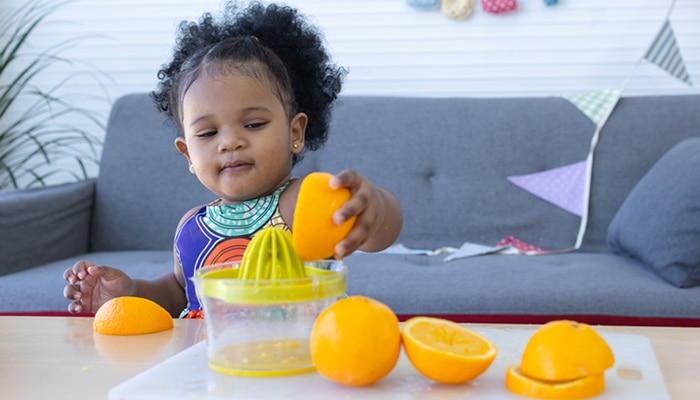While we believe that the books and resources recommended may be of value to you, keep in mind that these are suggestions only and you must do your own due diligence to determine whether the materials are appropriate and suitable for your use. PNC has no sponsorship or endorsement agreement with the authors or publishers of the materials listed.
FARM TO PRESCHOOL

Where Do Fruits Grow?
Children will investigate where fruits come from and will make orange juice.

Lesson Objective
Children will investigate different fruits and learn that some fruits, including oranges, come from trees; then, they will make orange juice
Science
What You'll Need
NOTE: Download Fruit Pictures before getting started
- Pictures of fruit trees
- Pictures of fruits that grow on trees: banana, apple, peach, orange, pear, cherry, apricot, lemon, lime, plum
- Pictures of fruits that grow on vines: strawberry, grape, pumpkin, watermelon
- Pictures of fruits that grow on bushes: raspberry, currant, blueberry
- Oranges – 1 per 2 children
- Knife or orange-peeling tool (adult use only)
- Quart-sized, freezer-weight, zip-close bags – 1 per child
- Small paper cups – 1 per child
- Scissors (adult use only) – 1 pair
What To Do
Note: Before the start of the lesson, place a colored dot on each of the fruit pictures – red for fruits that grow on trees, green for fruits that grow on vines, and yellow for fruits that grow on bushes.
- Display an orange, and ask the children to describe it and to indicate where they might find an orange (see Guiding Student Inquiry).
- Ask the children where they think oranges grow.
- Display the fruit plant pictures, and tell the children that not all fruit grows on the same type of plant. Some fruits grow on trees, some on bushes, and others on vines.
- Ask if any of the children have ever been to an orchard or farm where they could pick their own fruit from the plant; have them describe their experience (see Lesson Tips).
- Distribute 1 fruit picture to each child.
- Tell the children that all of the fruit pictures with red dots are fruits that grow on trees, fruit pictures with green dots are fruits that grow on vines, and fruit pictures with yellow dots are fruits that grow on bushes.
- Have the children sort the pictures into piles according to the type of plant that the fruit grows on.
- Ask the children the type of plant that oranges grow on and what type of drink we make from oranges.
- Tell them that today, they are going to make orange juice to drink.
- Peel the oranges, and have the children describe what they see.
- Place half of the slices from 1 peeled orange into a zip-close bag for each child, and secure the closure.
- Have the children gently squish and squeeze their orange sections.
- As children finish, snip a tiny corner off of each bag, and pour the juice into a cup for them to drink.
Resources
Home School Resources
Home educators: use these printable lesson PDFs to teach this lesson to your home schoolers. They're available in English and Spanish.
Content Provided By
Common Core State Standards Initiative – These lessons are aligned with the Common Core State Standards ("CCSS"). The CCSS provide a consistent, clear understanding of the concepts and skills children are expected to learn and guide teachers to provide their students with opportunities to gain these important skills and foundational knowledge [1]. Visit the CCSS



